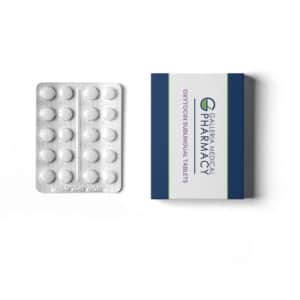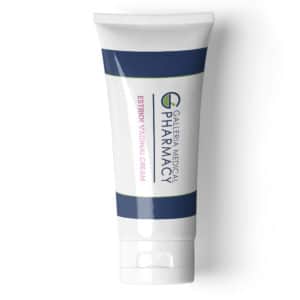DHEA Cream for Women
- Home
- /
- Products
- /
- Hormone Replacement
- /
- DHEA Cream for Women

Overview
Dehydroepiandrosterone (DHEA) and its metabolite dehydroepiandrosterone sulfate (DHEA-S) are the most abundant circulating human adrenal steroids. Considered as the “mother hormone,” DHEA is a steroid precursor to androstenedione, testosterone, and estradiol. It is made in the adrenal glands, skin, and brain. DHEA is thought to be important in several endocrine processes, but current medical use of DHEA is mostly limited to controlled clinical trials. Over 500 scientific articles investigating DHEA have been published since the early 1990’s. Many of the clinical trials of DHEA to date have been short-term studies and have lacked a powerful study design and statistical significance needed to support therapeutic claims. The following actions are a small sampling of the various effects that DHEA appears to have on the body:
- DHEA may be made by the central nervous system. Concentrations of DHEA are higher in the brain than in other organs and it appears to have excitatory activity at both GABA and NMDA receptors.1
- Animal studies have shown that DHEA expedites the re-epithelialization of donor skin-graft sites after a burn injury.2
- DHEA can be converted to androstenedione, testosterone, and estradiol by peripheral tissues.1
- DHEA has demonstrated an inhibition of platelet aggregation after 14 days of administration. The degree of inhibition appears to be time and dose dependent.3
- DHEA’s effect on the immune system is not clear, however DHEA has been shown to increase the numbers of natural killer cells in aging women.1
- Lower levels of DHEA have been noted in patients with systemic lupus erythematosus (SLE) at the time of diagnosis. Chronic corticosteroid treatment may cause adrenal atrophy, contributing to lowered DHEA levels in these patients. Supplementation of DHEA in SLE may augment immune system activity and potentially offset the undesired effects of chronic corticosteroid use in these patients.4
Additionally, research shows that DHEA may be responsible for several positive physiological effects including: reduced inflammation, improved insulin sensitivity, blood flow, cellular immunity, body composition, bone metabolism, sexual function, and physical strength in frailty and provides neuroprotection, improves cognitive function, and memory enhancement. In addition, DHEA has been studied to reduce the symptoms of andropause in aging men. However, while reduced levels of DHEA and DHEA-S may be associated with several pathologies, the clinical efficacy of DHEA supplementation in ameliorating pathophysiological symptoms remains to be evaluated.6, 7, 8
Indications
Symptoms of painful intercourse and vaginal atrophy may be a result of menopause. Vaginal DHEA formulations have been studied to alleviate these symptoms.
How Supplied
Commercially-Available DHEA Options
DHEA is widely available as an over-the-counter nutritional supplement. In November 2016, DHEA was also approved by the FDA under the brand name IntrarosaTM to treat women experiencing moderate to severe pain during sexual intercourse, a symptom of vulvar and vaginal atrophy (VVA), due to menopause.5
Compounded DHEA Options
As determined by a prescriber, DHEA may be compounded for patients that would benefit clinically from a higher dosage or topical administration of DHEA. DHEA is typically compounded into a cream and dispensed in a 30 mL Topi-Click device, though other strengths and versions are also available upon request. Common formulations prepared at Galleria Medical Pharmacy include but are not limited to:
DHEA Cream 5 mg/mL
DHEA Cream 10 mg/mL
DHEA Cream 25 mg/mL
DHEA Cream 50 mg/mL
Storage
*
Reference
- Kroboth PD, Slalek FS, Pittenger AL et al. DHEA and DHEA-S: a review. J Clin Pharmacol 1999;39:327-348.
- Araneo BA, Ryu SY, Barton S, et al. Dehydroepiandrosterone reduces progressive dermal ischemia caused by thermal injury. J Surg Res 1995;59:250-262.
- Jesse Rl, Loesser K, Eich DM, et al. Dehydroepiandrosterone inhibits human platelet aggregation in vitro and in vivo. Ann N Y Acad Sci 1995;774:281-290.
- Sawalha AH, Kovats S. Dehydroepiandrosterone in systemic lupus erythematosus. Curr Rheumatol Rep. 2008 Aug; 10(4): 286–291.
- Intrarosa (prasterone) vaginal insert package insert. Quebec City, Canada: Endoceutics, Inc.; 2018 Feb.
- Traish AM, Kang HP, Saad F, Guay AT: Dehydroepiandrosterone (DHEA)—A precursor steroid or an active hormone in human physiology. J Sex Med2011;8:2960–2982; quiz 2983.
- Baker WL, Karan S, Kenny AM: Effect of dehydroepiandrosterone on muscle strength and physical function in older adults: A systematic review. J Am Geriatr Soc2011;59:997–1002
- Luci M, Valenti G, Maggio M: [Dehydroepiandrosterone [DHEA(S)]: Anabolic hormone?]. Recenti Prog Med2010;101:333–344.
Compounding Pharmacy Statement
DHEA cream is compounded with drug components whose suppliers are registered with the FDA. While Galleria Medical Pharmacy adheres to USP <795> guidelines and applicable state and federal regulations to meet the required quality standards, the statements made regarding compounded DHEA cream have not been evaluated by the FDA for safety or clinical effectiveness. As such, this preparation is not intended to diagnose, treat, cure, or prevent any disease. For inquiries concerning this preparation, please contact (504) 267-9876.





